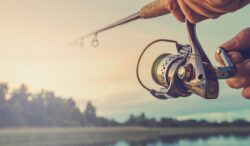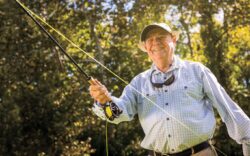Casting a line takes some skill. You also need to practice. Eventually, muscle memory and feel will take over. Casting becomes second nature.
Originally, fishermen used cane poles and fixed line length rigs. Fly casting is more like this type of casting. All the line needs to go backward before it can go forwards. This style of casting is also more like a swing, like the pendulum on an old clock.
Fly fishing gets more interested when you add a heavier fly line, a reel, and a leader. Shorter leaders are easier to address than leaders over 9 feet long. You are never casting a fly, instead you are throwing a line. Everything must go back before it can go forwards.
CASTING KEYS
Timing It is important when you release or unload the cast. Once the rig is all the way backwards, move the rod forward and release in the direction you want.
Look and see Turn and watch your back cast. This will allow you see when the back cast has completely loaded and extended the cast. Now come forward. Aim the rod tip where you want the fly, bait, or lure to go.
Pick a target Accuracy is important. Not getting snagged helps you to avoid snags and loss of gear. Fish are also around snags, logjams, and structure. Proper placement is vital.
Pick gear you are comfortable with
Length matters The longer the rod, the longer and easier the cast. You can also catch a bigger fish on a longer rod. Rods are levers and will do the work if you let them.
Load the rod When a rod flexes back or forward, it is loading energy. This loading magnifies and lengthens your cast.
Cast from different positions Sometimes we are standing, seated in a boat, perched on a log, or walking while we cast. Practice all angles and positions.
Rods are for casting reels are not A reels main job is to retrieve line and absorb the power of a fish using the drag. A drag can be adjusted to allow the fish to pull out line without breaking it. You can use lighter line than the weight and power of the fish with a primo drag.
Spin fishing is not like fly casting When you spin fish, the weight of the lure, bait, spinner, plug, or fish attractor pulls the line off the reel. The flexy rod accelerates the cast and adds distance.
Trolling rods are not for casting Trolling rods are designed for reeling in fish but not casting. The reel has a great drag but no bail. You need to unlock the drag/clutch and let out the amount of line you want. Then close the drag and put the rod into a holder. Make sure the drag is set light to absorb the strike.
Lefty Kreh fly casting videos are the BEST! We are visual learners. Lefty was the greatest fisherman that ever cast a fly or lure. He was amazing. His explanation s about casting are educational and amusing. Take advantage of local fishing shows where casting instruction is offered.
Feel the cast You can feel the back cast and timing, after you practice. You can also feel a malfunction before it happens.
Ice rods are not for casting Most icemen are fishing vertically. You simply need to open the bail on a spinning reel and let the line sink to the depth you want. If you are marking fish a t a specific depth, estimate the distance by stepping off the distance. Use this mark to measure your cast.
Slapping the water scares the fish Big lures, weights and lures make noise when the smack the water. When fly fishing you normally want the fly to gently land on the water. During hopper time, you can slap the hopper onto the water. Fish can sometimes be attracted to sound and vibration. Slapping your fly line, rod, and gear onto the water is normally a fish spooker.
The great thing about fishing is that you will improve, but never master the sport. There is always something new and different to do or learn. Remembering what you did right will help you do more things correctly. You should come home form every outing with some new lessons learned.
Tight lines, bent rods, and screaming reels!
Montana Grant